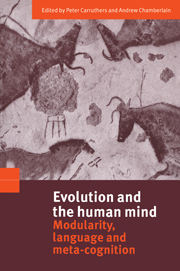Book contents
- Frontmatter
- Contents
- List of contributors
- Preface
- 1 Introduction
- 2 Massively modular minds: evolutionary psychology and cognitive architecture
- 3 Individual differences in early understanding of mind: genes, non-shared environment and modularity
- 4 Darwin in the madhouse: evolutionary psychology and the classification of mental disorders
- 5 Evolution of the modern mind and the origins of culture: religious concepts as a limiting-case
- 6 Symmetry and the evolution of the modular linguistic mind
- 7 Evolution, communication and the proper function of language
- 8 The evolution of knowledge
- 9 Mind, brain and material culture: an archaeological perspective
- 10 The evolution of strategic thinking
- 11 On the origin of the human mind
- 12 The evolution of consciousness
- 13 Evolution, consciousness and the internality of the mind
- References
- Author index
- Subject index
7 - Evolution, communication and the proper function of language
Published online by Cambridge University Press: 18 December 2009
- Frontmatter
- Contents
- List of contributors
- Preface
- 1 Introduction
- 2 Massively modular minds: evolutionary psychology and cognitive architecture
- 3 Individual differences in early understanding of mind: genes, non-shared environment and modularity
- 4 Darwin in the madhouse: evolutionary psychology and the classification of mental disorders
- 5 Evolution of the modern mind and the origins of culture: religious concepts as a limiting-case
- 6 Symmetry and the evolution of the modular linguistic mind
- 7 Evolution, communication and the proper function of language
- 8 The evolution of knowledge
- 9 Mind, brain and material culture: an archaeological perspective
- 10 The evolution of strategic thinking
- 11 On the origin of the human mind
- 12 The evolution of consciousness
- 13 Evolution, consciousness and the internality of the mind
- References
- Author index
- Subject index
Summary
Language is both a biological and a cultural phenomenon. Our aim here is to discuss, in an evolutionary perspective, the articulation of these two aspects of language. For this, we draw on the general conceptual framework developed by Ruth Millikan (1984), while at the same time dissociating ourselves from her view of language.
Biological and cultural evolutionary processes
The phrase ‘evolution of language’ refers to two related but quite distinct processes: the biological evolution of a language faculty, and the historical-cultural evolution of languages. The historical-cultural evolution of languages itself requires the repetition across populations and over generations of the individual process of language acquisition. Individuals who have acquired the language of their community can engage in verbal communication. Through a myriad of acts of communication, they achieve a variety of effects, intended or unintended. The aggregation of these effects explains both the biological evolution of the language faculty and the historical-cultural evolution of languages.
The biological evolution of a language faculty and the historical-cultural evolution of languages are related in interesting ways. If we assume, with Chomsky, that human languages require, to be acquired, a language faculty, it follows that the biological emergence of this faculty is a precondition for the cultural emergence of any human language. On the other hand, if we think, without Chomsky this time, of the language faculty as a biological adaptation, then presumably its function – at least its proximate function on the successful performance of which other functions depend – is to make language acquisition possible.
- Type
- Chapter
- Information
- Evolution and the Human MindModularity, Language and Meta-Cognition, pp. 140 - 169Publisher: Cambridge University PressPrint publication year: 2000
- 107
- Cited by

